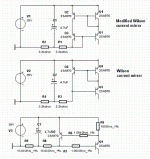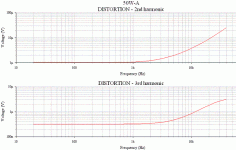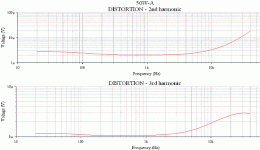AKSA said:
So, our amplification process should keep all harmonic generation low order, with particular emphasis on avoiding H5 and higher, and it should be clean, and as linear as possible, to avoid the blight of 'sum/difference' intermodulations, which typically give a muddy, vague sound.
That said, when one listens to a good quality system from afar, and then a genuine musical instrument, like Christer's Grand Piano in the apartment above, the skilled listener can clearly pick up the difference. Why is this, and once we identify it, could this be the key to producing truly realistic sounds?
Nice post, Hugh. Indicates that you have passed the way through.
Pavel
AKSA said:
2. Now, music is also about mood - and discord is a part of this manipulation. Rikard Strauss, Rachmaninov, many of the tone poem composers, even Sibelius and the later Beethoven String Quartets, ALL exhibit strong discord from time to time. This music is not everyone's cup of tea, but it is deeply evocative to me, and clearly the discordant balance is very carefully structured.
Discords are very important in a lot of music as you point out.
However, as I am sure you meant but just didn't emphasize, it
is used deliberatly for dramatic effects by the composers,
similar to juxtaposition of complementary colours in painting etc,
and we do not want our audio equipment to introduce such
effect in places they were not intended by the composer.
The best distorsion spectrum is no distorsion spectrum, but
that is more than we can ask for, of course.
Of course, this is as practical as riding a beaver across the Sahara, ...
I'll give you the gold star of the week for that one, Hugh.
Of course, to open another can of words, the dreadful truth is that the recording process is probably as guilty of corrupting the music as the playback - and arguably more so.
Much more so. Guess why I usually prefer historical recordings,
apart from their usually superior musical qualities. I received a
CD this morning that a friend had posted to me of a modern,
although not from the most recent years, recording of Faurés
Requiem, which he thought was an example of the few modern
recordings that actually sound good. He even seemed to think
it sounded better than Ansermets recording on Decca from 1955
which we both admire. Just did some quick comparisons, but
crap, it is decent, but not at all like the old Decca. Where is the
acoustics around the choir and orchestra, why can't I hear
that the choir is actually spread out over the soundstage and
not just located at a single point, why does it sound as if the
choir distors in the fortes? Ok, the Decca also has some distorsion
in the fortes, but there I can still hear what they are singing.
Thank you PMA and Christer!
The star of the week is actually a literary metaphor.
To complete the picture, and see just how grubby and dry my humour is, see Roald Dahl's 'Uncle Oswald', a wonderful story with a captivating twist........
Actually, did you know that using a bipolar and a mosfet, it is possible to build a unity gain buffer with an input impedance of 200K and an output impedance of 40 milliohms? Only local feedback, no global.
Cheers,
Hugh
The star of the week is actually a literary metaphor.
To complete the picture, and see just how grubby and dry my humour is, see Roald Dahl's 'Uncle Oswald', a wonderful story with a captivating twist........

Actually, did you know that using a bipolar and a mosfet, it is possible to build a unity gain buffer with an input impedance of 200K and an output impedance of 40 milliohms? Only local feedback, no global.
Cheers,
Hugh
By the way, what exactly is a current/active mirror?
Can someone explain this to me? Or show a schematic?
Thanks!
Audiofanatic
P.S. I like both tube and SS!
sss said:whats a wilson current source ?
what do u think of using chip based current source in the lpt?
Can someone explain this to me? Or show a schematic?
Thanks!
Audiofanatic
P.S. I like both tube and SS!
MIRROR, MIRROR ON THE WALL....
Hi,
A quick refreshment on current sources:
BJT CURRENT MIRRORS
Cheers,
Hi,
Now, don't ask me what that is, I always mix up Wilson and Widlar current mirrors, and only remember what one of them looks like, not knowing which of them it is.
A quick refreshment on current sources:
BJT CURRENT MIRRORS
Cheers,
Sorry about the confusion, it`s wilson current MIRROR, and wildar current SOURCE. My mistake, I`m mixing them too...
Ref.:
-Micrelectronic circuits 4th ed." by Sedra/Smith
-"Analoge kretser og komponenter" (analouge circuits and compnents) by Rolf Ingebrigtsen
When we desire a current source I<10uA, wildar is perfect, output impedance >10Mohms. (these values are very ca. and are solely dependent on beta and Va
A modified wilson has output impedance >1Mohm`s (assuming high-beta BJT`s). An ideal current source has infinite output impedance, this is specially important in the input stage (differental amp).
Higher output impedance in the current source means higher CMRR and PSRR, and greater linearity, combined with an active load (current mirror), the preformance is second to none -whatsoever!!!
Compared to the "shcoolbook" design of the diff. amp with resistors (and even the transistor-diode current source) the difference is 1/100-1/1000 and often more)!!
Regardless, there are people claiming otherwise, but that`s wrong, you can`t cheat on physics!!
Ref.:
-Micrelectronic circuits 4th ed." by Sedra/Smith
-"Analoge kretser og komponenter" (analouge circuits and compnents) by Rolf Ingebrigtsen
When we desire a current source I<10uA, wildar is perfect, output impedance >10Mohms. (these values are very ca. and are solely dependent on beta and Va
A modified wilson has output impedance >1Mohm`s (assuming high-beta BJT`s). An ideal current source has infinite output impedance, this is specially important in the input stage (differental amp).
Higher output impedance in the current source means higher CMRR and PSRR, and greater linearity, combined with an active load (current mirror), the preformance is second to none -whatsoever!!!
Compared to the "shcoolbook" design of the diff. amp with resistors (and even the transistor-diode current source) the difference is 1/100-1/1000 and often more)!!
Regardless, there are people claiming otherwise, but that`s wrong, you can`t cheat on physics!!
-Your case (without Q5) output resistance is ro=Va/Ic
-My case (with Q5) The output resistance for the wilson is Rout=beta*ro/2
=beta*(Va/Ic)2
Assume a Va=100V, and Ic=1mA and beta=200:
-Your case:
Rout=100V/1mA=100kohm.
-My case
Rout=200*(100V/1mA)/2=10Mohm.
I can assure you that preformance will be improved! (CMRR will in theory be doubled)
-My case (with Q5) The output resistance for the wilson is Rout=beta*ro/2
=beta*(Va/Ic)2
Assume a Va=100V, and Ic=1mA and beta=200:
-Your case:
Rout=100V/1mA=100kohm.
-My case
Rout=200*(100V/1mA)/2=10Mohm.
I can assure you that preformance will be improved! (CMRR will in theory be doubled)
PanzerLord said:-Your case (without Q5) output resistance is ro=Va/Ic
-My case (with Q5) The output resistance for the wilson is Rout=beta*ro/2
=beta*(Va/Ic)2
Assume a Va=100V, and Ic=1mA and beta=200:
-Your case:
Rout=100V/1mA=100kohm.
-My case
Rout=200*(100V/1mA)/2=10Mohm.
I can assure you that preformance will be improved! (CMRR will in theory be doubled)
THANK YOU!
Audiofanatic
I have now replaced the modified wilson current mirror with a standard current mirror (two BJT`s ).
If I have replaced the active load (a standard wilson current mirror) on the input diff. amp. on both cases, the difference would have been far more noticable...
If I have replaced the active load (a standard wilson current mirror) on the input diff. amp. on both cases, the difference would have been far more noticable...
Attachments
.The seccond one is the one I'm using(without Q5) but didn't know the name of it.
A standard current mirror Rout=ro=VA/Ic
Since some confusion seem to still be around, and I found out
what confused me, maybe it can help somebody else.
As is well known, a current mirror can be used as a current
source by tying a CCS to (or elsewise draw a constant current
from) one half of the mirror. The other half will then replicate
this current source, more or less perfectly depending on the
mirror topology etc. When Panzerlord referred to a Wilson
CCS he actually meant a Wilson current mirror used as a CCS
in the way described above. I just had never heard the term
Wilson CCS before, but the concept is well known, of course.
Then is the question what is won by this since the constant
current to be replicated seems not generated by a CCS in
his case but by an RC net, but his simulations seem to
indicate advantages.
what confused me, maybe it can help somebody else.
As is well known, a current mirror can be used as a current
source by tying a CCS to (or elsewise draw a constant current
from) one half of the mirror. The other half will then replicate
this current source, more or less perfectly depending on the
mirror topology etc. When Panzerlord referred to a Wilson
CCS he actually meant a Wilson current mirror used as a CCS
in the way described above. I just had never heard the term
Wilson CCS before, but the concept is well known, of course.
Then is the question what is won by this since the constant
current to be replicated seems not generated by a CCS in
his case but by an RC net, but his simulations seem to
indicate advantages.
Yes, good point.
You can also use the Wilson Current Mirror as a current multiplier by configuring non-symmetrical emitter degeneration. I have seen this done with triodes to effect impedance transformation without a transformer. VERY cool!!
However, I've done a lot of work on current mirrors, which are yet another elegant engineering solution to a problem which scarcely exists. The problem is that they are an active load, and this introduces more non-ohmic behavior into the mix at the point where the diff pair drives the voltage amplifier. I have shown mathematically, some year or two ago now on this forum, that even with a perfect current mirror, the single ended take off drives the diff pair into asymmetry; precisely what we don't want. I have found that PP SS amplifiers sound better without them.
Cheers,
Hugh
You can also use the Wilson Current Mirror as a current multiplier by configuring non-symmetrical emitter degeneration. I have seen this done with triodes to effect impedance transformation without a transformer. VERY cool!!
However, I've done a lot of work on current mirrors, which are yet another elegant engineering solution to a problem which scarcely exists. The problem is that they are an active load, and this introduces more non-ohmic behavior into the mix at the point where the diff pair drives the voltage amplifier. I have shown mathematically, some year or two ago now on this forum, that even with a perfect current mirror, the single ended take off drives the diff pair into asymmetry; precisely what we don't want. I have found that PP SS amplifiers sound better without them.
Cheers,
Hugh
- Status
- This old topic is closed. If you want to reopen this topic, contact a moderator using the "Report Post" button.
- Home
- Amplifiers
- Solid State
- Transistor sound


